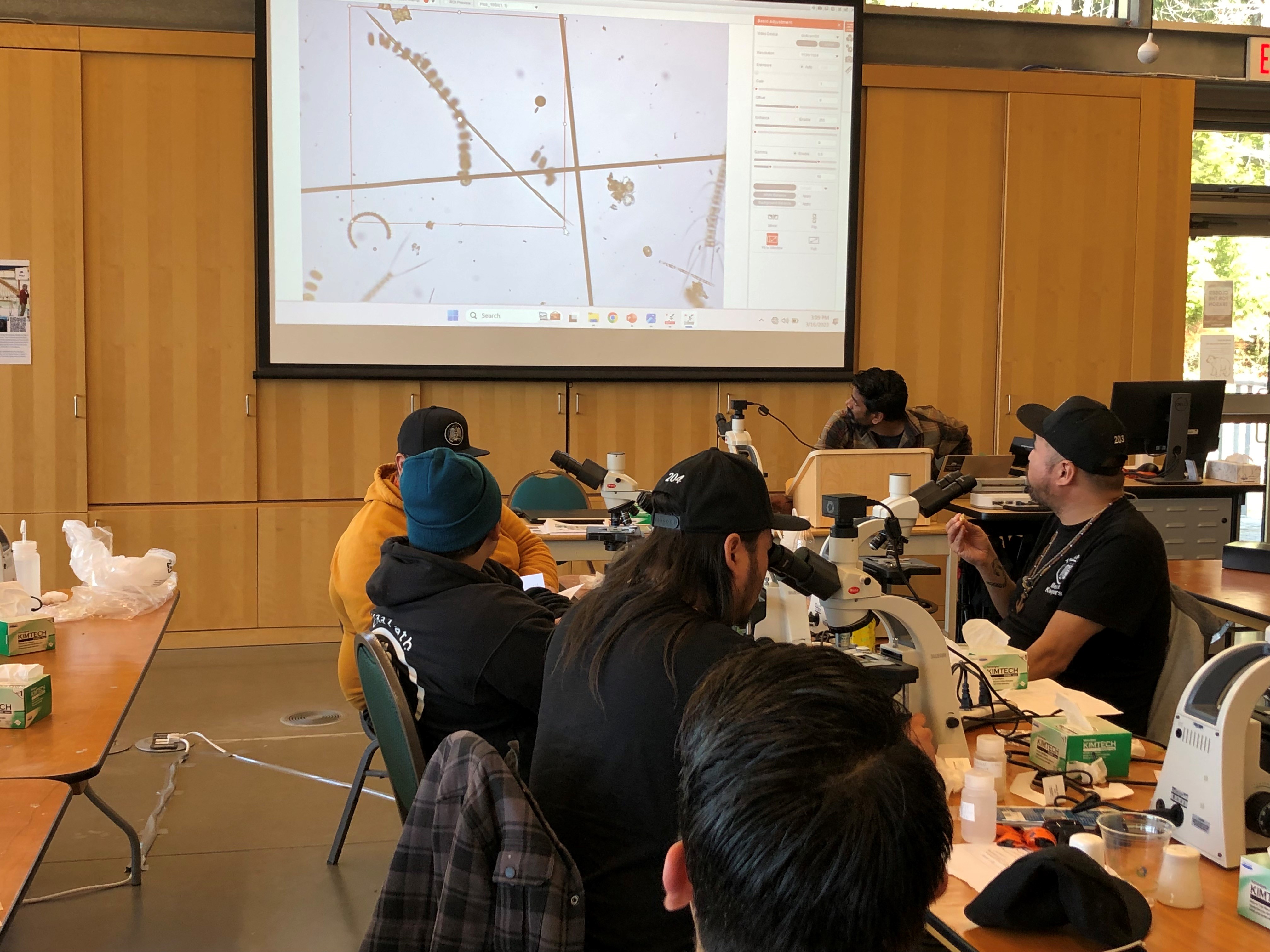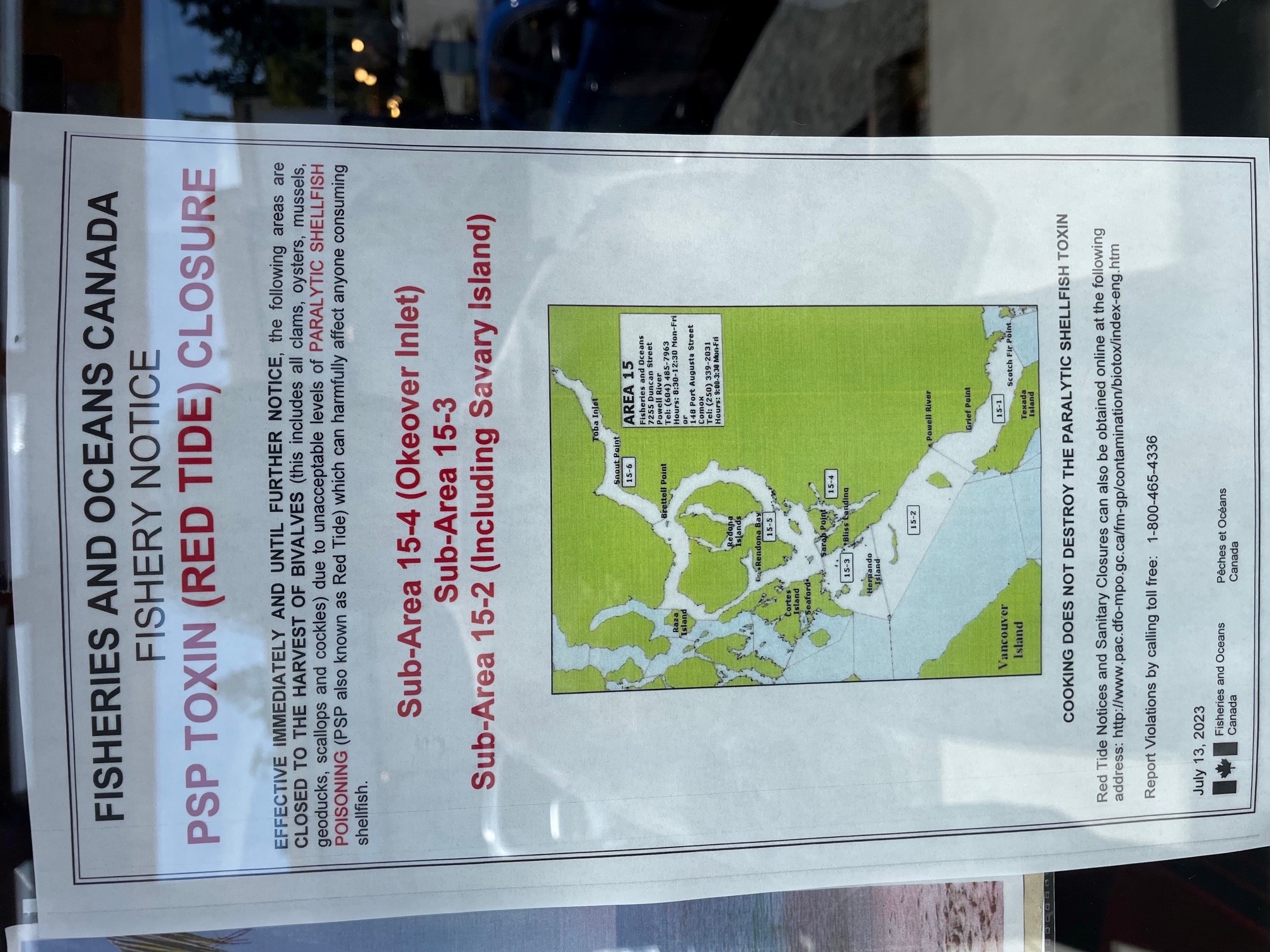The WATCH project doubled its monitoring capacity this spring, with Stz'uminus First Nation, Snuneymuxw First Nation, Tla'amin Nation, and Tsawout First Nation establishing community-based Harmful Algal Bloom (HAB) monitoring programs. We gratefully welcome these Nations to the WATCH monitoring community and honour the enthusiasm and knowledge they so graciously share. With each experience and every story, we are better equipped to advance the systems changes that are needed to support seafood safety in a warming world.
WATCH Project Lead Holly Clermont recounts how testing with Tla'amin Nation this June identified dangerously high levels of Alexandrium, a single-celled organism that when ingested can cause sickness and even death. The Tla'amin Guardians and other WATCH monitors are collecting data and providing alerts to their communities to support safe harvesting in a changing climate.
For many people, summer is a time of harvesting the many varieties of shellfish from the ocean. Setting crab and prawn traps in fine weather or digging clams when the tides are low.
Surveying more than 30 people harvesting on a beach on Okeover Inlet, Tla'amin Guardian Andrew Timothy notes they are all recreational harvesters from outside the community. One is shucking oysters and hungrily eating them, raw. It is June 19. Andrew says that Tla'amin community members are unlikely to harvest clams and oysters this time of year, because they know red tides are more common.
The term 'red tide' typically refers to blooms of the phytoplankton (tiny plant)
Alexandrium, a single-celled organism that produces potent and dangerous saxitoxins, which are neurotoxins that accumulate in shellfish and can sicken and even kill people with Paralytic Shellfish Poisoning (PSP). They are more common in the summer months and, because of a changing climate, may now occur in our waters in every month of the year if conditions are right for a bloom. Warm seas and plentiful nutrients are key ingredients. WATCH calls these Harmful Algal Blooms (HABs). Some blooms aren't always red and can even be colourless.

In March 2023, WATCH Phytoplankton Specialist Jay Pudota introduces newl WATCH Project participants into the world of monitoring. Photo: Holly Clermont
On June 19 WATCH phytoplankton specialist Jay Pudota joined the Guardians for their first WATCH training day in the field. Together with trainers from the U.S., he had introduced the Guardians to WATCH monitoring last November, and provided small group training with other community monitors in March. This day, the Guardians are ready to select their sample sites and try out their new equipment and supplies. They collect water samples from the beach and head back to the office. Through the microscope, they find more than 170 Alexandrium cells in a single ml of water. Pudota comments this is the largest concentration he has seen to date. It's not good news. Just one cell in this amount of water is enough to warrant closing a beach to harvesting.
They consult Fisheries and Oceans Canada (DFO)'s Shellfish harvesting and safety map and the BC Centre for Disease Control (BCCDC) Shellfish Harvest Status Map and confirm the beach is still open to harvesting. The Canadian Sanitary Shellfish Program (CSSP) uses mussels as the "sentinel species" to represent risk in other bivalve shellfish. Sentinel species are organisms, often animals, used to detect risks to other animals or humans by providing advance warning of a danger. The most recent MARTOX (Marine Toxin) report issued by the Canadian Food Inspection Agency (CFIA) and DFO shows that Blue mussels last tested for saxitoxins were clean, at <25 ugSTXdiHCl eq/100g shellfish tissue. The mussels were collected a week earlier however, on June 12, and the group does not know the location of the CSSP sample sites.
Based on their findings, Tla'amin Nation prepares an alert for community members, notifies onsite recreational harvesters of the presence of Alexandrium in the area, and contacts DFO. They would later discover that a member had been hospitalized with PSP symptoms after a meal of local Spot prawns harvested prior to their notifications.
Crabs and prawns accumulate toxins in their digestive tract and should be cleaned before cooking to avoid contamination of the meat. De-vein prawns and remove the carapace (hard upper shell) and viscera (guts) of crabs. Potentially toxic shellfish waste should be carefully discarded to avoid harming pets or other animals.
The story does not end here. A new MARTOX report was produced June 23 for mussels collected on the same day the phytoplankton samples were taken, June 19. Although levels were 40 ug toxin/100g, still well below the 80 ug/100g threshold for beach closures, a following mussel sample collected June 26 was a whopping 20 times higher, 1,600 ug/100g. A prohibition order to close the beaches was announced June 30, eleven days after the extraordinary phytoplankton sample was collected. CFIA tested mussels each week thereafter, recording unacceptable levels on July 3 and 10.

Fisheries and Oceans Canada Posts a PSP Toxin (Red Tide) Closure effective immediately - eleven days after the initial sample was tested for high amounts of Alexandrium by the Tla'amin Guardians on June 19. Photo: Jay Pudota
In an eastern Canadian study assessing the use of mussels as a sentinel species, Rourke et al. (2021) noted that mussels concentrate and break down toxins rapidly in comparison to other species - so quickly in fact that spikes in toxin levels may be missed even with weekly testing. The authors also noted that higher toxin production can be observed with relatively low Alexandrium cell counts. Importantly, they found that peak Alexandrium counts coincided with peak concentrations of toxins in mussels. They reasoned that phytoplankton monitoring can provide valuable complementary data for Paralytic Shellfish toxin monitoring programs. The WATCH project urges the CSSP to consider phytoplankton monitoring to triage and fine-tune our shellfish program, similar to the collaborative system employed by the Washington State Department of Health.
Mussels are also relatively insensitive to high toxin levels so will keep feeding when other species will not. Similarly, Butter clams have a special resistance to saxitoxin but also bind the toxins, holding onto them for long periods. At the same time, increases in toxin levels are delayed in oysters relative to mussels. Therefore, mussels are not always representative of the risks when multiple species are present in a harvest area (Rourke et al., 2021). The WATCH project supports a laboratory testing regime that enables pre-catch or catch-and-hold testing of shellfish species on request by harvesters, in addition to regular testing of sentinel species. Several initiatives are underway to increase lab capacity for shellfish testing.
With unprecedented rises in global sea surface temperatures, a large marine heat wave reaching our shores this summer, and a moderate to strong El Niño anticipated in the fall, we can expect conditions to create Alexandrium blooms and other HABs in the months ahead. The Tla'amin Guardians and other WATCH monitors are collecting data and providing alerts to their communities to support safe harvesting during these extraordinary times.
Also See: The Critical Role of Phytoplankton Monitoring for Seafood Safety and Security (Nov. 29, 2022)
More from WATCH!
If you do not yet have access to a WATCH monitoring program, please consult the Toxic Shellfish bulletin, Safe Harvest Resources on the FNHA WATCH web page.
In the coming months, WATCH for these events:
- Summer 'Seasonal Reflections' workshop, Sept. 12, on Zoom, 10am-12pm - Everyone welcome
- Monitoring Community of Practice meeting, Understanding and Communicating Risk, Oct. 25, Deep Bay Marine Field Station - By invitation only
- Autumn 'Seasonal Reflections' workshop, Dec. 6th, on Zoom, 1-2:30 p.m. - Everyone welcome
- Seafood Contaminants of Concern in a Changing Climate, early 2024 - Everyone welcome
- Winter 'Seasonal Reflections' workshop, March 6, on Zoom, 1-3:30 p.m. - Everyone welcome
Please contact watch-project@fnha.ca if you would like additional information or to be added to our contact lists.
Citation:
Rourke, W. A., Justason, A., Martin, J. L., & Murphy, C. J. (2021). Shellfish Toxin Uptake and Depuration in Multiple Atlantic Canadian Molluscan Species: Application to Selection of Sentinel Species in Monitoring Programs. Toxins, 13(2), Article 2. https://doi.org/10.3390/toxins13020168

